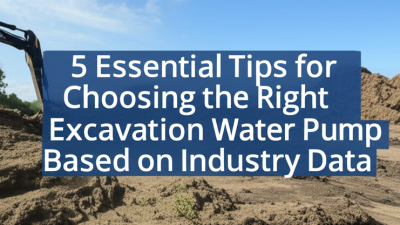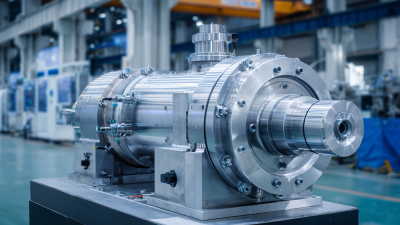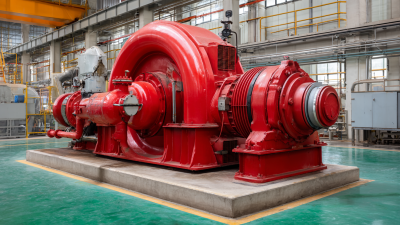When it comes to selecting the right Excavation Water Pump, understanding the landscape of the industry is crucial for making an informed decision. According to a recent report by Grand View Research, the global water pump market is projected to reach USD 75 billion by 2025, driven by increasing demands in construction and industrial applications. Additionally, the National Utility Contractors Association highlights that improper pump selection can lead to inefficiencies and increased operational costs, accounting for nearly 20% of unexpected delays on excavation projects. Selecting the appropriate Excavation Water Pump not only enhances project efficiency but can also significantly reduce maintenance expenses and downtime. In this guide, we will explore the five essential tips necessary for making the right choice based on industry data, ensuring that contractors are well-equipped to tackle the challenges of any excavation project.

When selecting the right excavation water pump for construction projects, several critical factors must be taken into account to ensure efficiency and safety. The nature of the job site is paramount; for instance, sites prone to heavy groundwater seepage require pumps with higher capacities. Understanding the parameters such as flow rate, lift height, and the type of fluid being handled are essential for effective pumping operations.
Another key consideration is the technology and features of the pump. Modern pumps offer advanced functionalities that can significantly reduce operational costs while enhancing performance. Look for pumps equipped with automatic controls and energy-efficient designs that minimize power consumption, ultimately benefiting the project's bottom line. Additionally, proper maintenance and ease of transport should also guide your decision, especially for deep excavations common in urban construction.
Tips for making an informed decision include thoroughly assessing the specific water management needs of your project, comparing performance metrics of different pump models, and consulting with industry experts to understand current best practices. Always prioritize safety and efficiency, as improper pump selection can lead to project delays and increased expenses.
When selecting an excavation water pump, understanding performance ratings is vital for making an informed decision. Two key metrics in this evaluation are gallons per minute (GPM) and head pressure. GPM measures the flow rate of the pump, indicating how much water it can move in a minute. A higher GPM means the pump can effectively handle larger volumes of water, which is essential in excavation projects where rapid dewatering is often necessary to maintain safety and efficiency.
Head pressure, on the other hand, refers to the height that water can be pumped vertically. It is crucial when determining the pump's ability to lift water from deep excavation sites. Each project may have different head pressure requirements depending on the terrain and depth of the excavation. Therefore, understanding both GPM and head pressure not only ensures the pump can meet the demands of the job but also helps in optimizing fuel efficiency and cost-effectiveness during operation. Always align these specifications with the project’s needs to select the right pump for the task at hand.
| Pump Type | GPM (Gallons Per Minute) | Head Pressure (Feet) | Power Source | Weight (lbs) | Applications |
|---|---|---|---|---|---|
| Submersible Pump | 200 | 30 | Electric | 50 | Construction & Draining |
| Diaphragm Pump | 150 | 20 | Diesel | 65 | Mining & Agriculture |
| Centrifugal Pump | 300 | 50 | Electric | 75 | Flood Control & Irrigation |
| Trash Pump | 250 | 40 | Gasoline | 70 | Construction & Waste Management |
| Piston Pump | 100 | 60 | Hydraulic | 80 | Mining & Heavy Duty |
When selecting an excavation water pump, the material from which the pump is constructed plays a vital role in its longevity and efficiency, especially in harsh environments. High-quality materials such as stainless steel or cast iron can significantly enhance the pump's resistance to corrosion and wear. Pumps made with these materials are better equipped to handle abrasive sediments and harsh chemicals typically found in excavation sites, thus reducing maintenance costs and downtime.
One essential tip for choosing the right pump is to assess the material based on the specific working conditions it will face. For instance, if the pump will be exposed to saltwater or acidic environments, a corrosion-resistant material is essential. Additionally, consider the temperature extremes of the environment; certain materials may not perform well under severe heat or cold, affecting the overall efficiency of the pump.
Another important consideration is the pump's design features that complement the chosen material. A well-designed pump will leverage its material strengths, ensuring optimal performance while navigating the rigors of excavation tasks. Look for pumps that offer features like reinforced components to enhance durability alongside the right material choice. By focusing on these aspects, you can select a pump that ensures reliability and efficiency in challenging conditions.
When selecting an excavation water pump, understanding industry trends in pump technology is crucial for ensuring optimal performance. The global home water pump market is projected to grow from approximately $18.58 billion in 2024 to an estimated $26.92 billion by 2032, reflecting a robust CAGR of 4.8%. This growth indicates a significant increase in demand for various types of pumps that cater to different applications, including excavation.
Moreover, the dry vacuum pump market is experiencing similar momentum, with the global market size expected to exceed $4.68 billion by 2025. Industry reports forecast a compound annual growth rate (CAGR) of over 5.1%, suggesting that technological advancements and increased product development are driving this sector. These trends highlight a broader movement towards efficiency and innovation across pumping technologies, emphasizing the need for careful consideration when choosing the right equipment for excavation tasks, particularly in light of evolving market demands and technological enhancements.
This chart illustrates the critical performance metrics of excavation water pumps based on recent industry data. The flow rate, maximum head, pump efficiency, durability, and cost data points help in identifying the optimal choices for excavation projects.
When selecting an excavation water pump, budgeting plays a crucial role in ensuring both cost-effectiveness and quality. It’s important to start by defining the specific needs of your project, including the volume of water to be pumped, the type of materials encountered, and the duration of usage. These factors heavily influence the choice between hiring or purchasing a pump. Evaluate your budget not just in terms of initial costs, but also consider the long-term operating expenses, including maintenance, fuel, and electricity.
Quality should remain a priority even when working within a budget. Opting for lower-cost options can sometimes lead to increased maintenance costs or equipment failure, which can derail your project timeline. Research reputable brands and read industry reviews to find a reliable pump that matches your price point. Additionally, consider the warranty and support services offered, as these can provide added assurance that your investment is protected while ensuring that the equipment performs optimally throughout its use in the field. Balancing cost and quality requires careful planning, but it can lead to significant savings and enhanced efficiency in excavation projects.






